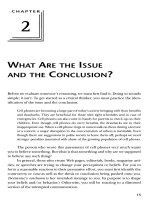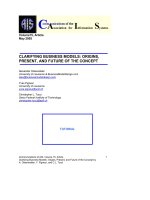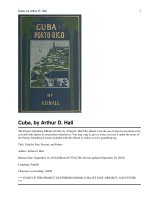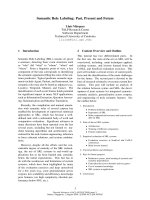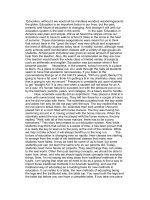Paleoclimate what can the past tell us about the present and future
Bạn đang xem bản rút gọn của tài liệu. Xem và tải ngay bản đầy đủ của tài liệu tại đây (1.43 MB, 36 trang )
Paleoclimate:
What can the past tell us about
the present and future?
12.340 Global Warming Science
February 14, 2012
David McGee
1
Recent observed trends:
Greenhouse gases
Image courtesy of NOAA.
2
Recent observations:
Land surface temperature
Climate Change 2007: The Physical Science Basis. Working Group I Contribution to the Fourth Assessment Report
of the Intergovernmental Panel on Climate Change, Figure 3.1. Cambridge University Press. Used with permission.
3
Recent observations:
Sea surface temperature
Land
Sea
Climate Change 2007: The Physical Science Basis. Working Group I Contribution to the Fourth Assessment Report
of the Intergovernmental Panel on Climate Change, Figure 3.8. Cambridge University Press. Used with permission.
4
Recent observations:
Drought
Climate Change 2007: The Physical Science Basis. Working Group I Contribution to the Fourth Assessment Report of the
Intergovernmental Panel on Climate Change, FAQ 3.2, Figure 1. Cambridge University Press. Used with permission.
5
Recent observations:
Sea ice
Public domain image courtesy of National Snow and Ice Data Center, University of Colorado, Boulder.
6
Recent observed trends:
Glacier extent
Muir Glacier, Alaska
Public domain image courtesy of National Snow and Ice Data Center, University of Colorado, Boulder.
7
Recent observed trends:
Glacier extent
Public domain image courtesy of National Snow and Ice Data Center, University of Colorado, Boulder.
8
Recent observed trends:
Ice sheet mass loss
This image has been removed due to copyright restrictions.
Please see Figure 2 on />
9
Recent observed trends:
Sea level rise
Climate Change 2007: The Physical Science Basis. Working Group I Contribution to the Fourth Assessment Report of the
Intergovernmental Panel on Climate Change, Figure SPM.3. Cambridge University Press. Used with permission.
10
Given these observations,
what questions do you have that
records of the pre-instrumental past
could help answer?
11
How do we get information about
past climates?
Climate archives
• ice cores
• tree rings
• ocean and lake sediments
• corals
• fossils
• glacial features
• boreholes
• stalagmites
12
Image courtesy of NASA.
A paleoclimatic tour
from 400 to 1 Myr ago
(with a few interruptions)
This image has been removed due to copyright restrictions.
Please see the photo on
/>
13
Climate and CO2 over the last 400 Myr
Climate Change 2007: The Physical Science Basis. Working Group I Contribution to the Fourth Assessment Report
of the Intergovernmental Panel on Climate Change, Figure 6.1. Cambridge University Press. Used with permission.
14
This image has been removed due to copyright restrictions.
Please see: Figure 2. Beerling, D. J., & Royer, D. L. (2011).
Convergent Cenozoic CO2 history. Nature Geoscience,
4(7), 418–420. doi:10.1038/ngeo1186
15
Oxygen isotopes:
Versatile recorders of paleoclimatic
conditions
Image courtesy of NASA.
16
Oxygen isotope fractionation
As a general rule of thumb, 18O tends to be enriched
relative to 16O in the most “immobile” state involved in
a reaction or transformation
Figure: more energy is needed
to break bonds involving
heavier isotopes (in this case,
H-H vs. H-D vs. D-D, where
D=2H, H=1H)
17
Figure by MIT OpenCourseWare.
Oxygen isotope fractionation
Fractionation increases with decreasing temperature
Figure: δ18O enrichment
in cultured foraminifera
vs. temperature
This image has been removed due to copyright restrictions.
Figure by MIT OpenCourseWare., after Erez et al., 1983
18
Climate over the last 65 Myr
(beware the flipping x-axis…)
This image has been removed due to copyright restrictions.
Please see Figure 2 in
/>
19
Oxygen isotope fractionation
Water vapor is depleted in 18O relative to liquid water
due to the greater mass of H218O vs. H216O
Air masses become more 18O-depleted with
increasing rain-out and decreasing temperatures
20
Image courtesy of NASA.
Oxygen isotope fractionation
Because ice sheets are made with 18O-depleted
precipitation, ice sheet growth causes global oceans
to be enriched in 18O.
As a result, global oceans at the peak of the last
glacial period had δ18O ~1‰ more positive than at
present
21
Climate over the last 65 Myr
(beware the flipping x-axis…)
This image has been removed due to copyright restrictions.
Please see Figure 2 on
/>
22
Climate and CO2 over the last 65 Myr
This image has been removed due to copyright restrictions.
Please see: Figure 1. Beerling, D. J., & Royer, D. L. (2011).
Convergent Cenozoic CO2 history. Nature Geoscience,
4(7), 418–420. doi:10.1038/ngeo1186.
23
The Pliocene, 5.3-2.6 Myr ago
• pCO2 likely ~400 ppmv
• Continents near present positions
• Abundant marine and terrestrial sediments
available for study
24
The Pliocene, 5.3-2.6 Myr ago
Reconstructed global average
temperature ~2-3 ˚C warmer
than at present
Annual average SST anomaly
USGS PRISM3 project
25
Image courtesy of USGS.


